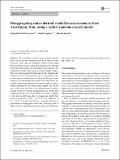| dc.contributor.author | Fouladi Osgouei, Hojjatollah | |
| dc.contributor.author | Zarghami, Mahdi | |
| dc.contributor.author | Ashouri, Hamed | |
| dc.date.accessioned | 2016-09-30T22:48:55Z | |
| dc.date.available | 2017-03-01T16:14:48Z | |
| dc.date.issued | 2016-04 | |
| dc.date.submitted | 2015-11 | |
| dc.identifier.issn | 0177-798X | |
| dc.identifier.issn | 1434-4483 | |
| dc.identifier.uri | http://hdl.handle.net/1721.1/104637 | |
| dc.description.abstract | The availability of spatial, high-resolution rainfall data is one of the most essential needs in the study of water resources. These data are extremely valuable in providing flood awareness for dense urban and industrial areas. The first part of this paper applies an optimization-based method to the calibration of radar data based on ground rainfall gauges. Then, the climatological Z-R relationship for the Sahand radar, located in the East Azarbaijan province of Iran, with the help of three adjacent rainfall stations, is obtained. The new climatological Z-R relationship with a power-law form shows acceptable statistical performance, making it suitable for radar-rainfall estimation by the Sahand radar outputs. The second part of the study develops a new heterogeneous random-cascade model for spatially disaggregating the rainfall data resulting from the power-law model. This model is applied to the radar-rainfall image data to disaggregate rainfall data with coverage area of 512 × 512 km[superscript 2] to a resolution of 32 × 32 km[superscript 2]. Results show that the proposed model has a good ability to disaggregate rainfall data, which may lead to improvement in precipitation forecasting, and ultimately better water-resources management in this arid region, including Urmia Lake. | en_US |
| dc.description.sponsorship | East Azarbaijan Regional Water Company | en_US |
| dc.publisher | Springer Vienna | en_US |
| dc.relation.isversionof | http://dx.doi.org/10.1007/s00704-016-1784-z | en_US |
| dc.rights | Article is made available in accordance with the publisher's policy and may be subject to US copyright law. Please refer to the publisher's site for terms of use. | en_US |
| dc.source | Springer Vienna | en_US |
| dc.title | Disaggregating radar-derived rainfall measurements in East Azarbaijan, Iran, using a spatial random-cascade model | en_US |
| dc.type | Article | en_US |
| dc.identifier.citation | Fouladi Osgouei, Hojjatollah, Mahdi Zarghami, and Hamed Ashouri. “Disaggregating Radar-Derived Rainfall Measurements in East Azarbaijan, Iran, Using a Spatial Random-Cascade Model.” Theor Appl Climatol (April 4, 2016). | en_US |
| dc.contributor.department | MIT Sociotechnical Systems Research Center | en_US |
| dc.contributor.mitauthor | Zarghami, Mahdi | |
| dc.relation.journal | Theoretical and Applied Climatology | en_US |
| dc.eprint.version | Author's final manuscript | en_US |
| dc.type.uri | http://purl.org/eprint/type/JournalArticle | en_US |
| eprint.status | http://purl.org/eprint/status/PeerReviewed | en_US |
| dc.date.updated | 2016-08-18T15:21:28Z | |
| dc.language.rfc3066 | en | |
| dc.rights.holder | Springer-Verlag Wien | |
| dspace.orderedauthors | Fouladi Osgouei, Hojjatollah; Zarghami, Mahdi; Ashouri, Hamed | en_US |
| dspace.embargo.terms | N | en |
| mit.license | PUBLISHER_POLICY | en_US |
